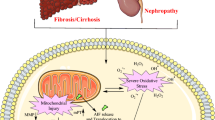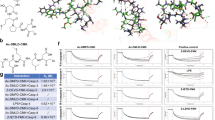Abstract
Background Cholestasis leading to retention and accumulation of toxic hydrophobic bile salts within hepatocytes may cause hepatocyte toxicity by inducing apoptosis. Calpains have been found to be involved in apoptosis of many cell systems. This study is designed with the aim of evaluating the possible effect of Z-LLY-FMK (a calpain inhibitor) on hepatocyte apoptosis after bile duct ligation in rat. Materials and Methods Male Sprague-Dawley rats were randomized to five groups. Group 1 (C) underwent sham operation. Group 2 (CDMSO) underwent Sham operation and simultaneous treatment with dimethylsulfoxide (DMSO). Group 3 (OB) underwent common bile duct ligation. Group 4 (OBZLLY) underwent common bile duct ligation and simultaneous treatment with Z-LLY-FMK. Group 5 (OBZFA) underwent common bile duct ligation and simultaneous treatment with ZFA-FMK. After 3 days, liver tissue was harvested for histopathologic analysis and apoptosis measurements. Results When compared with sham operation groups, increased hepatocyte apoptosis (P < 0.001) and ductular proliferation (P < 0.001) occurred after common bile duct ligation. Following administration of Z-LLY-FMK, the increased hepatocyte apoptosis and ductular proliferation after common bile duct ligation were significantly diminished (P < 0.001 and P < 0.001). Moreover, administration of ZFA failed to show the same phenomenon (P = 0.9 and 0.987). Conclusion Significantly increased hepatocyte apoptosis and ductular proliferation occurred after common bile duct ligation. The administration of Z-LLY-FMK could effectively diminish the hepatocyte apoptosis and ductular proliferation after common bile duct ligation, whereas the administration of ZFA-FMK failed to show the same effect.


Similar content being viewed by others
References
Kerr JFR, Wyllie AH, Currie AR (1972) Apoptosis: a basic biology phenomenon with wide-ranging implication in tissue kinetics. Br J Cancer 26:239–257
Allen RT, Hunter WJ III, Agrawae DK (1997) Morphological and biochemical characterization and analysis of apoptosis. J Pharmacol Toxicol Methods 37:215–228
Cohen GM (1997) Caspases: the executioners of apoptosis. Biochem J 326:1–16
Seiger CP (1992) Anthranoid laxative and colorectal cancer. Trends Pharmacol Sci 13:229–231
Branconnier RJ, Branconnier ME, Walshe TM et al (1992) Blocking the Ca(+2) activated cytotoxic mechanisms of cholinergic neuronal death: a novel treatment strategy for Alzheimer’s disease. Psychopharmacol Bull 28:175–178
Trauner M, Meier PJ, Boyer JL (1998) Molecular pathogenesis of cholestasis. N Engl J Med 339:1217–1227
Miyoshi H, Rust C, Roberts PJ et al (1999) Hepatocyte apoptosis after bile duct ligation in the mouse involves Fas. Gastroenterology 117:669–677
Patel T, Bronk SF, Gotes GJ (1994) Increases of intracellular magnesium promote glycodeoxycholate-induced apoptosis in rat hepatocytes. J Clin Invest 94:2183–2192
Rodrigues CMP, Fan G, Xiaoming M et al (1998) A novel role for ursodeoxycholic acid in inhibiting apoptosis by modulating mitochondrial membrane perturbation. J Clin Invest 101:2790–2799
Webster CR, Anwer MS (1998) Cyclic adenosine monophosphate-mediated protection against bile acid-induced apoptosis in cultured rat hepatocyte. Hepatology 27:1324–1331
Faubion WA, Guicciardi ME et al (1999) Toxic bile salts induce rodent hepatocyte apoptosis via direct activation of Fas. J Clin Invest 103:137–145
Benz C, Angermuller S, Tox U et al (1998) Effect of tauroursodeoxycholic acid on bile-acid-induced apoptosis and cytolysis in rat hepatocyte. J Hepatol 28:99–106
Rodrigues CM, Fan G, Wong PY et al (1998) Ursodeoxylcholic acid may inhibit deoxycholic acid-induced apoptosis by modulating mitochondrial transmembrane potential and reactive oxygen species production. Mol Med 4:165–178
Vanags DM, Porn-Ares MI, Coppola S et al (1996) Protease involvement in fodrin cleavage and phosphatidylserine exposure in apoptosis. J Biol Chem 271:31075–31085
Wood DE, Newcomb EW (1999) Caspase-dependent activation of calpain during drug-induced apoptosis. J Biol Chem 274:8309–8315
Sheen-Chen SM, Chau P, Harris HW (1998) Obstructive jaundice alters Kupffer cell function independent of bacterial translocation. J Surg Res 80(2):205–209
Sheen-Chen SM, Chen HS, Ho HT, Chen WJ, Sheen CC, Eng HL (2002) Effect of bile acid replacement on endotoxin-induced tumor necrosis factor-alpha production in obstructive jaundice. World J Surg 26:448–450
Sheen-Chen SM, Ho HT, Chen WJ et al (2002) Obstructive jaundice alters CD44 expression in rat small intestine. Digestion 65:112–117
Sheen-Chen SM, Chen HS, HO HT et al (2003) Obstructive jaundice alters LFA-1 alpha expression in rat small intestine. Dig Dis Sci 48:1165–1170
Sheen-Chen SM, Ho HT et al (2003) Obstructive jaundice alters proliferating cell nuclear antigen expression in rat small intestine. World J Surg 27:1161–1164
Trauner M, Meier PJ, Boyer JL (1998) Molecular pathogenesis of cholestasis. N Engl J Med 339:1217–1227
Benz C, Angermuller S, Tox U, Kloters-Plachky P et al (1998) Effect of tauroursodeoxycholic acid on bile acid-induced apoptosis and cytolysis in rat hepatocytes. J Hepatol 28:99–106
Faubion WA,Guicciardi ME, Miyoshi H et al (1999) Toxic bile salts induce rodent hepatocyte apoptosis via direct activation of Fas. J Clin Invest 103:137–145
Kashio Y, Nakamura K, Abedin MJ et al (2003) Galectin-9 induces apoptosis through the calcium–calpain–caspase-1 pathway. J Immunol 170:3631–3636
Acknowledgment
This study was supported by grant CMRP G8047 from the Chang Gung Memorial Hospital, Chang Gung University.
Author information
Authors and Affiliations
Corresponding author
Rights and permissions
About this article
Cite this article
Sheen-Chen, SM., Ho, HT., Hung, KS. et al. Z-LLY-FMK Can Attenuate Hepatocyte Apoptosis After Bile Duct Ligation in Rat. Dig Dis Sci 53, 2975–2979 (2008). https://doi.org/10.1007/s10620-008-0306-y
Received:
Accepted:
Published:
Issue Date:
DOI: https://doi.org/10.1007/s10620-008-0306-y




